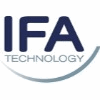RIPPERT ANLAGENTECHNIK GMBH & CO. KG - planning, production and installation of state-of-the-art plant equipment
Germany
Manufacturer/ Producer
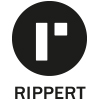

RIPPERT ANLAGENTECHNIK GMBH & CO. KG
Germany
Lackieranlagen aus dem Hause Rippert sind vielseitige Alleskönner. Autoteile, Möbelstücke oder Kunststoffzubehör können damit präzise lackiert werden und Sie haben darüber hinaus die Möglichkeit manuelle Elemente wie Spritztische oder -wände sowie automatisierte Komponenten zu kombinieren. Natürlich können wir Lackierabläufe mit Hilfe modernster Robotik für Sie auch vollautomatisiert ablaufen lassen. Bei Rippert entwickeln und planen wir Lackieranlagen gemeinsam mit Ihnen, um alle Voraussetzungen für die optimale Oberflächenbehandlung Ihrer Produkte zu schaffen. Vom Werkstück für PKW über einzelne Bestandteile von Möbeln bis zur Oberflächenbehandlung von ganzen Kunststoffplatten zur späteren Weiterverarbeitung ist alles möglich. Unsere Anlagen stehen für modernste Technik und höchste Effizienz! Eine Lackieranlage muss heute vielen Anforderungen genügen. Sicherlich muss diese Komponente im Anlagenbau in erster Linie dafür sorgen, dass Lacke gleichmäßig auf die Werkstücke aufgetragen werden. In Zeiten des steigenden Kostendrucks müssen Lackieranlagen darüber hinaus immer kostensparender arbeiten. Wir planen und montieren deshalb Anlagen, die höchst effizient mit einem Maximum an Leistung für ein Minimum an Kosten für Sie arbeiten, ohne dass dabei Qualitätseinbußen entstehen. Darüber hinaus ist der Umweltschutz ein wichtiger Faktor. Durch aufwändige Filtertechniken und Abscheidefunktionen erfüllen unsere Anlagen selbst strengste Umweltschutzauflagen.
Request for a quote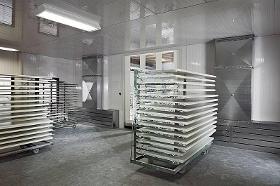
RIPPERT ANLAGENTECHNIK GMBH & CO. KG
Germany
For forced drying. Drying rooms Drying rooms offer the possibility to make the drying process faster and more comprehensible through forced drying. Depending on the paint systems, the temperature and humidity of the air can be adapted to suit the special requirements. In the high-gloss field in particular, special filters ensure the demanded degree of purity. Depending on the size and the specific task, Rippert also offers its drying rooms with heat recovery.
Request for a quote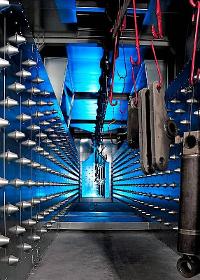
RIPPERT ANLAGENTECHNIK GMBH & CO. KG
Germany
For series production. Continuous flow dryer Continuous flow dryers are used wherever components need to be dried during transport in series production. Regardless of whether an adhesive water dryer, a paint dryer or a powder enamelling furnace is required, Rippert offers a wide range of heating and aeration options. Special air-locks or air circulation systems ensure low heat losses. IR zones can also accelerate the drying result or reduce the necessary energy quantities.
Request for a quote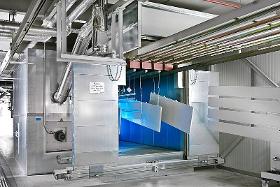
RIPPERT ANLAGENTECHNIK GMBH & CO. KG
Germany
Chamber dryers are ideal for small lot sizes and intermittent drying. Chamber dryers are suitable for the batch drying of the most diverse goods and for large-format parts with long drying times. The drying process can be individually adapted to the parts by means of the drying duration or temperature. The dryers are fed either manually or fully automatically.
Request for a quote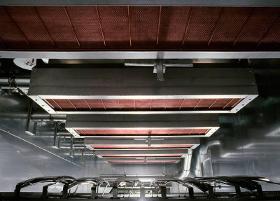
RIPPERT ANLAGENTECHNIK GMBH & CO. KG
Germany
Infrared ovens are suitable for powder, solvent-based and water-based paints. IR dryers Infrared ovens are particularly suitable for high material thicknesses or temperature-sensitive workpieces. In the drying of paint, infrared heat is often superior to conventional air drying, because the radiation penetrates the material and dries the paint film from the inside outwards. This hinders the formation of a skin or blisters on the surface and accelerates the drying of the paint. The result is a brilliant surface quality. On account of their outstanding powder wetting, these dryers are frequently used as gelling zones before powder enamelling furnaces. Advantages
Request for a quote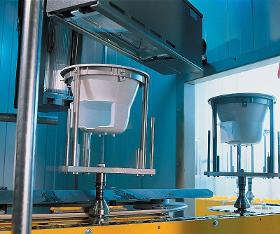
RIPPERT ANLAGENTECHNIK GMBH & CO. KG
Germany
UV radiation dryers are particularly suitable for UV-hardening paints. Ultraviolet drying process UV drying is a polymerisation process which is triggered by UV light. The process is primarily used for drying flat substrates, wood and furniture paints, overprint varnish on paper, printing inks etc. The process is environmentally compatible and of a particularly high quality. UV paint would never dry without UV light.
Request for a quote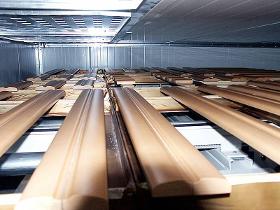
RIPPERT ANLAGENTECHNIK GMBH & CO. KG
Germany
Process with dry air. Dry-Air - Process with dry air Advantages Manufactured plants
Request for a quote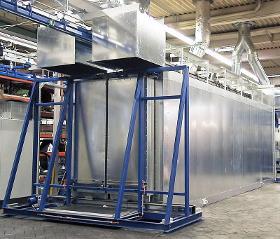
RIPPERT ANLAGENTECHNIK GMBH & CO. KG
Germany
For temperatures up to 450 °C. High-temperature furnaces Tempering furnace for car chassis stabilisers Previously cold-formed workpieces, e.g. stabilisers, are heated up in the tempering furnace at circulating air temperatures of up to 450°C and maintained at this temperature for an adjustable dwell time. This tempering increases toughness and dissipates residual stresses. Preheating furnace for frying pans and roasting tins Pan blanks are heated up to a temperature of approx. 390 °C and burnt free of all grease and oil residues. Enamelling furnace for frying pans and roasting tins The PTFE coating sprayed beforehand onto the frying pans is baked on at a temperature of approx. 450 °C. PTFE is used as a non-stick coating for frying pans and cooking pots on account of its low surface tension and good heat resistance. Chamber enamelling furnace for aluminium sheet metal forms Baking on of the single or multi-layer PTFE coatings at approx. 450 °C.
Request for a quote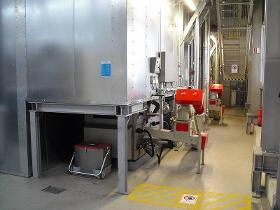
RIPPERT ANLAGENTECHNIK GMBH & CO. KG
Germany
Heating technology with a future The calculation is simple, the technology successful. Efficient surface drying is achieved with biomass in Rippert plants. Together with the Hargassner company from Austria, a specialist for heating with biomass, and the proven Rippert plant know-how, the technology is now marketable and has gone into production. The demanding drying characteristics in a powder-coating plant are compatible with the process and work perfectly. A future-orientated heating technology with considerable economic and ecological benefits – the experts are unanimous in that. Wood pellets or wood chips are the inexpensive energy suppliers. They are valuable waste products that result from the processing of domestic timbers. Heating with wood chips – without intermediate heat transfer media such as thermal oil • Environmentally friendly and CO2-neutral • fully automatic boiler cleaning and ash discharge Maximum financial saving potentials are realised with this energy carrier. Wood chips, chopped to a transportable size and dried by the supplier, are stored in the storeroom near the plant. It can be located on the same level or lower. A tried-and tested transport system consisting of a floor agitator with springs and discharge auger carries the wood chips reliably into the plant. Here it acts as a fuel with maximum convenience. If the calorific value equivalents are examined, we see that 1,000 litres of fuel oil is equivalent to 12 m³ of wood chips. The ratio is the same for 1,000 m³ of natural gas. Heating with wood pellets - without intermediate heat transfer media such as thermal oil Wood pellets are true energy bundles. They consist of natural wood and are made by compressing sawdust, which is produced in large quantities every day in the industry. As a biomass they are the alternative to wood chips and are just as advantageous from an economical point of view. Pellets have the smallest volume and are conveyed dust-free and without odours from storage containers to a storage vessel next to the plant. They are transported into the combustion chamber via a rotary vane feeder and feed auger. For comparison: 1,000 l fuel oil = 2 t pellets 1,000 m³ natural gas = 2 t pellets 1,000 l liquefied gas = 1.32 t pellets Advantages • Reduction in energy costs Heating cost comparison (reference = 1,000 l fuel oil)
Request for a quote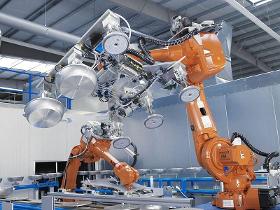
RIPPERT ANLAGENTECHNIK GMBH & CO. KG
Germany
Solutions for the transport and handling of parts. The question of how surface coating plants can be optimally integrated into a production environment arises with ever increasing frequency. Rippert offers its customer an ‘everything from one source solution’ here. The company’s own engineers develop coordinated solutions for the transport and handling of parts together with the customer. Simulation is thereby often the right tool for recognising the full potential of these possibilities. From frying pans to heavy workpieces from the wind power sector, Rippert has already ‘taken it all in hand’. We work on concepts in which industrial robots substitute or supplement the classic conveying equipment in coating plants. For handling tasks we often see the necessity for systems that work adaptively; this means that, for example, image processing systems must recognise the accurate position of parts in two and even three-dimensions so that a robot can pick up inaccurately positioned parts.
Request for a quoteManufacturer/ Producer
Paul-Rippert-Strasse 2-8
33442 Herzebrock-clarholz - Germany
europages also recommends
A selection of companies related to the activity:
A selection of products that might interest you
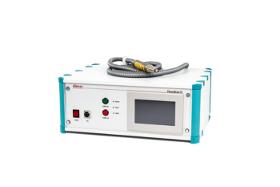
DIENER ELECTRONIC GMBH & CO. KG
Germany
Plasma systems from Diener electronic have long since established themselves in a wide variety of industrial sectors. With the PlasmaBeam PC atmospheric pressure plasma system, you can rely on modern and future-proof plasma jet technology under atmospheric pressure. Due to the treatment width of 8 - 10 mm, substrates can be precisely treated locally. PlasmaBeam technology can be used for inline processes. With the help of robots, 2 or 3-dimensional surfaces can be treated. PlasmaBeam enables local surface cleaning without masking the rest of the surface. For example, cleaning before wire bonding and various processes in the electronics industry. Furthermore, the PlasmaBeam PC is suitable as a pre-treatment device for the following processes: Gluing, bonding, printing, laminating, soldering, welding, flocking. The following surfaces can be treated with PlasmaBeam: Plastics, rubber, metal, glass, ceramics, hybrid materials.
Request for a quote
DIENER ELECTRONIC GMBH & CO. KG
Germany
Plasma systems from Diener electronic have long since established themselves in a wide range of industrial sectors. With the Tetra 1440 low-pressure plasma system, you can rely on modern and future-proof cold plasma technology in a vacuum. The chamber volume of approx. 1440 litres of this plasma system offers enough space to serve series production. Low pressure plasma treatment is a proven technique for controlled ultra-fine cleaning, adhesion enhancement (activation and etching) and coating of thin films on substrate surfaces. Plasma is generated by applying high-frequency voltage in the vacuum chamber. In the process, the process gas introduced there is ionised. Fields of application: VOC-free cleaning of organic residues Activation before painting, gluing, potting, ... Etching of PTFE, photoresist, oxide layers, ... Super-hydrophobic and -hydrophilic coatings
Request for a quote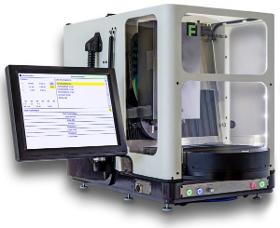
FÖHRENBACH GMBH
Germany
The machine structure with solid base plate is extremely compact and stable. All necessary components are integrated in the machine housing: mechanical axes, pneumatic components, control with drive electronics and mounted 12 "touch display. Depending on the desired version, the F-Décor 305 can produce surface patterns like circular grainings, côtes de Genève, engravings or decorative millings on mechanical watch parts. The machine guarantees high precision and high productivity. The F-Decor 305 is delivered ready for connection with either 1 or 2 working spindles.
Request for a quote
DIENER ELECTRONIC GMBH & CO. KG
Germany
Parylene is the short name for the polymer group of poly-para-xylylene. Parylene coatings offer a wide range of benefits. Parylene ... are fully conformal: i.e. they adapt to complex substrate contours such as sharp edges, drill holes or blind holes are pinhole-free from a film thickness of approx. 0.5 µm. are chemically insoluble and resistant to a wide range of chemicals. have very good barrier properties against moisture and chemicals. have a high dielectric strength. have dry lubricating properties (low coefficient of friction). are hydrophobic: contact angle of H2O between 92 ° and 98 °. are transparent between 90 and 96 % in the visible wavelength range (depending on type). are biocompatible: types C and N parylene can be deposited, which can be certified according to USP Class VI, ISO 10993 and FDA.
Request for a quoteRequest for quotes
Create one request and get multiple quotes form verified suppliers.
- Only relevant suppliers
- Data privacy compliant
- 100% free
